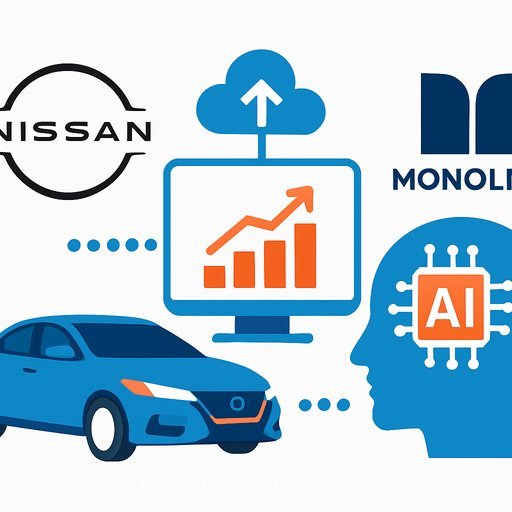Nissan extends its AI partnership to speed up car development
Nissan is tightening its build-measure-learn loop with AI. The company is extending its partnership with Monolith for three more years to compress development cycles, cut physical testing, and move decisions closer to data.
This isn't a PR line. In a pilot, Nissan dropped a slice of tests without sacrificing confidence. Now they're rolling the approach across more programs, anchored in the "Re:Nissan" strategy.
What changed: AI validation backed by 90 years of test data
Monolith's platform isn't a typical simulation stack. It learns from Nissan's historical test data - nearly a century's worth - and predicts real-world physical test outcomes with high accuracy.
Engineers at Nissan Technical Centre Europe (Cranfield, UK) are already using it. The initial use case: AI-validated torque ranges for screw tightening during development of the new all-electric Nissan Leaf.
Measured results so far
- 17% fewer physical tests in the pilot by having the model flag which tests were still worth running.
- Clearer prioritization: engineers spent less time repeating standard checks and more time solving edge cases.
- Nissan estimates that applying the same approach across its European lineup could cut testing time by up to half.
Key tools on the Monolith platform include the "Next Test Recommender" and an "Anomaly Detector." Together, they guide which experiments to run next and when results drift from expectations.
Why this matters for IT and engineering teams
AI-enabled validation turns physical testing into a tighter, data-driven loop. You don't brute-force every test - you run the right ones, at the right time, for the right reasons.
- Shift-left testing: identify likely failures earlier by predicting outcomes before committing to builds or rigs.
- Prototype efficiency: fewer prototypes, more learning per unit of time and spend.
- Decision clarity: engineers move from "test everything" to "test what changes the decision."
How the system likely works (in practical terms)
- Data foundation: aggregate decades of structured test results, sensor logs, and metadata; standardize units, conditions, and test IDs.
- Feature engineering: encode environmental conditions, torque/force curves, component variants, and prior outcomes.
- Modeling approach: supervised learning for outcome prediction; active learning to select the most informative next test.
- Human-in-the-loop: engineers verify recommendations, run targeted tests, and feed results back to improve the model.
- Ops: CI/CD for models, experiment tracking, and lineage for auditability; dashboards for uncertainty and risk.
What to copy if you build this internally
- Start narrow: pick a test domain with high volume and high cost (e.g., torque specs, durability cycles, NVH sweeps).
- Define the contract: what the model predicts, the acceptable error, and thresholds that trigger a physical test.
- Instrument for learning: every test run updates the data asset; treat tests as labeled examples, not just sign-offs.
- Track uncertainty: expose prediction intervals to engineers; make risk explicit, not implicit.
- Measure ROI: tests skipped, prototypes avoided, time-to-decision, and defect rate post-SOP.
Guardrails you'll need
- Data governance: versioned datasets, units consistency, and provenance across facilities and suppliers.
- Model drift monitoring: seasonal effects, new materials, and design changes can skew predictions.
- Safety-critical boundaries: for any life-safety domain, keep conservative thresholds for required physical validation.
- Change management: upskill test engineers to interpret model outputs and challenge them when needed.
Nissan's signals and what to watch next
Emma Deutsch from Nissan Technical Centre Europe notes reduced reliance on prototypes and faster delivery of new vehicles. Monolith's CEO, Dr. Richard Ahlfeld, points to cross-domain applicability across product development.
Watch for two metrics: percent of tests replaced or reprioritized by AI, and time from design freeze to validation sign-off. If Nissan hits its estimate, Europe programs could see roughly half the testing time.
Why Monolith is interesting
Monolith focuses on learning from physical test data, not replacing it entirely. That aligns with how complex systems actually behave - models guide where to look, physical tests ground truth the decisions.
For more on the company, see their site: Monolith AI. For broader context from the automaker, check Nissan's announcements: Nissan Newsroom.
If you're building similar capability
- Create a unified test data lake with strict schema and rich metadata.
- Pilot active learning: let the model propose the next best test; compare against your current test plan.
- Expose uncertainty to decision-makers and codify when a human review or physical test is mandatory.
- Integrate with PLM and requirements systems so recommendations tie directly to design decisions.
If your team needs structured upskilling on ML for engineering workflows, explore role-based AI training libraries here: Complete AI Training - courses by job.
Bottom line
Nissan's AI-assisted validation is a clear play: compress cycles, cut wasteful tests, and reserve human time for decisions that move the product. The early numbers are solid, and the approach scales.
For IT and development leaders, the pattern is repeatable: centralize test data, adopt model-driven test selection, keep humans in the loop, and measure what changes in time, cost, and quality.
Your membership also unlocks:






